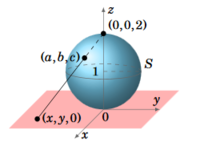Win_odd Dhamnekar
Junior Member
- Joined
- Aug 14, 2018
- Messages
- 212
Hello,
Let S be the sphere with radius 1 centered at (0,0,1),and let S∗ be S without the “north pole” point (0,0,2). Let(a,b,c) be an arbitrary point on S∗. Then the line passing through (0,0,2) and (a,b,c) intersects the xy-plane at some point (x,y,0), as in following figure . Now, how to find this point (x,y,0) in terms of a,b and c?
(Note: Every point in the xy-plane can be matched with a point on S∗, and vice versa, in this manner. This method is called stereographic projection, which essentially identifies all of R2 with a "punctured" sphere.

My attempt:-
Z coordinate of the intersection point is obviously zero. How to find X and Y coordinates of the intersection point. I assume S∗ is any point on/ inside sphere S.
Let S be the sphere with radius 1 centered at (0,0,1),and let S∗ be S without the “north pole” point (0,0,2). Let(a,b,c) be an arbitrary point on S∗. Then the line passing through (0,0,2) and (a,b,c) intersects the xy-plane at some point (x,y,0), as in following figure . Now, how to find this point (x,y,0) in terms of a,b and c?
(Note: Every point in the xy-plane can be matched with a point on S∗, and vice versa, in this manner. This method is called stereographic projection, which essentially identifies all of R2 with a "punctured" sphere.

My attempt:-
Z coordinate of the intersection point is obviously zero. How to find X and Y coordinates of the intersection point. I assume S∗ is any point on/ inside sphere S.
